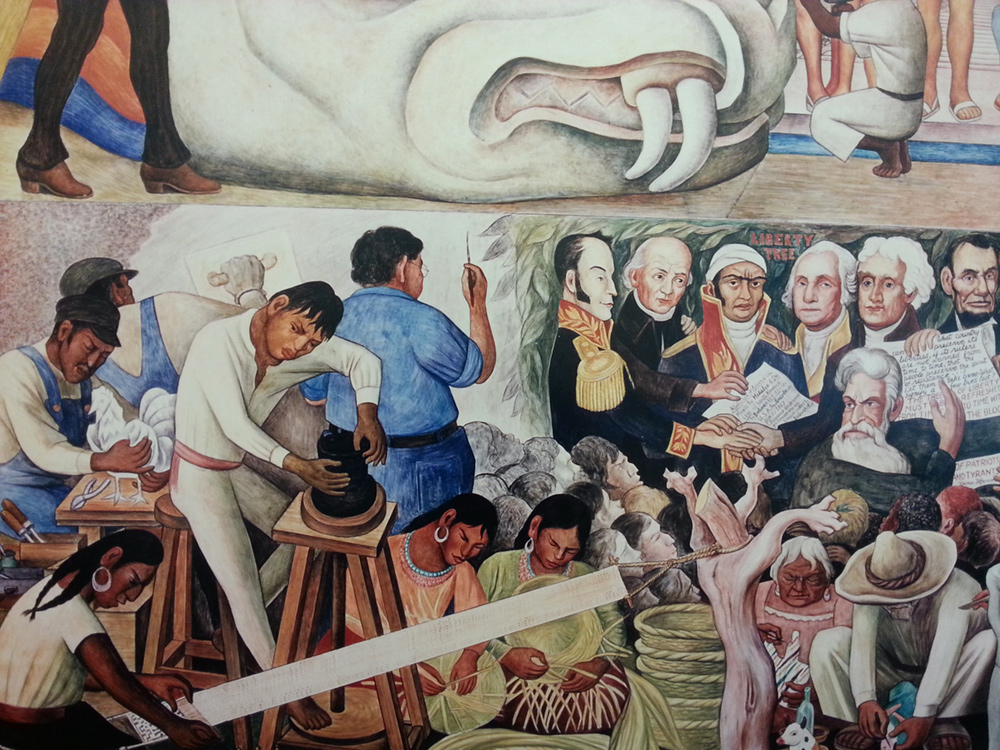
Creating and Sustaining an Environment for Influence (excerpt)
By B. Kim Barnes

Featured Art: “Pan American Unity” detail from mural by Diego Rivera
As leaders, we’re only too aware that we don’t know everything and can’t do everything by ourselves. We hire people with the knowledge and talent to accomplish great things – but sometimes we don’t see the results that we hope for. Change is slow; resistance is high to anything really new. People keep on doing that which is within their comfort zone. Innovation is rare. There is a murmur of complaints; morale is low. Results are disappointing. You begin to wonder whether you are dealing with a group of people who have no good ideas or who are focused on their lives outside of work – or even looking for their next job, rather than contributing value to the organization.
If you are ever faced with such a situation, consider the possibility that your organization is not seen as an influence-friendly environment. Perhaps a lot of good ideas walk out the door between the ears of employees. That could happen because people think that their ideas are not welcome or that they are not in a position where they will be heard. Or they may be fearful of the career or political consequences of disagreement with the status quo. Maybe, indeed, they have tried to influence others on their team or across organizational boundaries to no avail. And maybe they think that you and other leaders are not open to influence. So how can you as a leader create and sustain a climate in which ideas flow freely; where people communicate directly; where disagreement leads to better ideas rather than interpersonal conflict; where “common wisdom” is challenged and innovation is encouraged?
Following are seven simple (though not easy) leadership practices that will encourage influencing in all directions in your team or organization.
- Be clear with your team about ends; invite them to develop means.
Leaders who are clear with people about the goals they’e expected to accomplish and leave it to them to figure out how to do it are likely to gain the team’s engagement and ownership in the success of the project or task. This is certainly true for knowledge workers – there are a lot of years of study and practice represented in the team and it’s unlikely that you are the only one with the relevant knowledge and experience to achieve the goal. Professionals don’t like to waste their time as a “pair of hands” doing work that the boss has set them to – but anyone who takes pride in his or her ability to figure things out and apply brain power to the task at hand will appreciate the respect and trust implied by your leaving the approach up to them.
Of course, your team members should know that you’ll be available to discuss or even critique their thinking if they want that and that you’ll expect to be kept in the loop about progress. The opposite of micromanaging is not absence – it’s offering trust and support but staying out of the way.
Download the complete article (registration required)
Exercising Influence and the “New” Leadership
From the Barnes & Conti Blog
 Recently, the Fast Company website and magazine featured an article by Ludmilla N. Prasalova (Professor and Director of Industrial-Organizational Psychology at Vanguard University of Southern California) entitled, “We’re in the midst of a fundamental shift in leadership.”
Recently, the Fast Company website and magazine featured an article by Ludmilla N. Prasalova (Professor and Director of Industrial-Organizational Psychology at Vanguard University of Southern California) entitled, “We’re in the midst of a fundamental shift in leadership.”
“Leadership,” Prasalova begins, “comes in many forms, and right now, we are in the midst of a major change… Many examples of new leadership don’t fit the stereotypical image of positional power.”
So what are the images of the so-called “new leadership”? According to the article, “…And now, with remote and knowledge work limiting the usefulness of other sources of power, informational influence is becoming an increasingly important power.” The new leadership is founded on informational influence!
The author—citing “The Bases of Social Power” by social psychologist John French and Bertram Raven, (from Studies in Social Power)—define informational influence as follows:
“Informational Influence/power goes beyond the expert power by adding an element of learning. Not only does the leader know best, but the follower is developing an advanced understanding of why something is “best.” As a result, followers experience a change of mind and know the reason for action.”
To us, this informational influence sounds very much like the Expressive Influence tactics and behaviors that Barnes & Conti has been teaching for some 30+ years! For example:
- The Suggest Behavior (Tell tactic) can be used to share helpful information in a non-threatening way (“I would recommend that you…”)
- The Offer Reasons Behavior is self-explanatory for informational influence (“My analysis shows that…”)
- Perhaps more important, the Envision behavior (Encourage tactic) uses information to both inform and inspire the other to take action (“If we do x, I believe that in a year from now we…”)
As the article states:
“They (leaders) can lead through referent, expert, and informational power, using purpose-centered inspiration while changing work organization to replace domination with the focus on wellbeing, outcomes, flexibility, and participation.”
The article concludes, “Earning the respect of people and supporting them with care and dignity provide the relational foundation for the intrinsically inspired work.” And with 30+ years of teaching leaders influence skills, we would heartily agree.
Kim Barnes’ article, excerpted above, is full of practical advice on how to bring the "new" leadership to your team and workplace.
Introducing Rickey-Dean Wasson

Rickey-Dean Wasson joined the Barnes & Conti team this past spring as our new Curriculum Design and Development Consultant & Facilitator.
Rickey-Dean wears many hats including project management, instructional design, and facilitation. His background is in Musical Theatre, and he has performed across the US and Canada in many touring productions. He lived 22 years abroad in, London, Barcelona, and Belfast. When not helping customers achieve their goals, he can be found cycling, volunteering for worthwhile causes, or traveling.
Rickey-Dean is currently managing a client’s large-scale coaching implementation for emerging managers as well as updating some of our most popular programs.
Public Exercising Influence Program in October
If you missed our public offering of Exercising Influence this past July, we're offering the full version again in October as a virtual class/webinar in two parts:
- October 18, 2022: Session 1,
- October 25, 2022: Session 2
Both sessions: 9:00 am - 12:00 noon PDT
Webinar Cost: $925
Featured Recipe: Mostly Apples Cake
Here's a recipe from the collection of Kim Barnes, adapted from Snacking Cakes by Yossy Arafi and brought to you just in time for the first apples of the season.

Ingredients, Cake:
- 3/4 cup dark brown sugar
- 2 large eggs
- 1/2 cup canola oil
- 1 tsp vanilla
- 1 tsp cinnamon
- 1/4 tsp nutmeg
- 1/2 tsp kosher salt
- 1 cup flour
- 1 tsp baking powder
- 1/2 tsp baking soda
- 2 small apples, peeled, cored, and chopped into 1/4 to 1/2 inch pieces
- 1/2 cup toasted walnuts, chopped
Ingredients, Fudgy Caramel Icing:
- 1/4 cup unsalted butter
- 1/2 cup light brown sugar
- 1/4 cup heavy cream
- 1 tbsp water
- Pinch of kosher salt
- 1/2 cup confectioners’ sugar
- Flaky salt (optional)
Method:
- Preheat oven to 350. Butter an 8" square or round pan.
- In a large bowl, whisk brown sugar and eggs until pale and foamy, about 1 min. Add oil, vanilla, cinnamon, salt, and nutmeg. Whisk until smooth and emulsified.
- Add flour, baking powder, and baking soda; whisk until well-combined and smooth.
- Using a rubber spatula, fold in the apples and half of the nuts.
- Pour batter into prepared pan, gently smooth the top. Tap pan on counter, then sprinkle remaining nuts over the cake.
- Bake until puffed and golden, about 30 – 40 minutes. A tester should come out clean. Set pan on rack to cool.
- Make icing: melt butter, brown sugar, cream, and water together in a saucepan over medium heat. Bring mixture to a full boil, cook for 3 minutes. Turn off heat and allow to cool, stirring once or twice. After 3 minutes, whisk in salt and confectioners’ sugar until smooth. Spread over cooled cake and sprinkle with flaky salt if desired. Let icing set about 20 minutes before serving.
You are receiving these emails from Barnes & Conti because you are a client, colleague, and/or friend of Barnes & Conti Associates or you contacted us through our website, at a trade show, or via social media. Barnes & Conti does not sell, trade, or give away mailing lists or email addresses to anyone. Period. You can read our privacy policy here.
If you no longer wish to receive these bulletins, use this link to unsubscribe or write us at Barnes & Conti, 2342 Shattuck Ave, #217, Berkeley, CA 94704.
*Please don't forward this entire email; the person you forward to might inadvertently unsubscribe you with the above link!